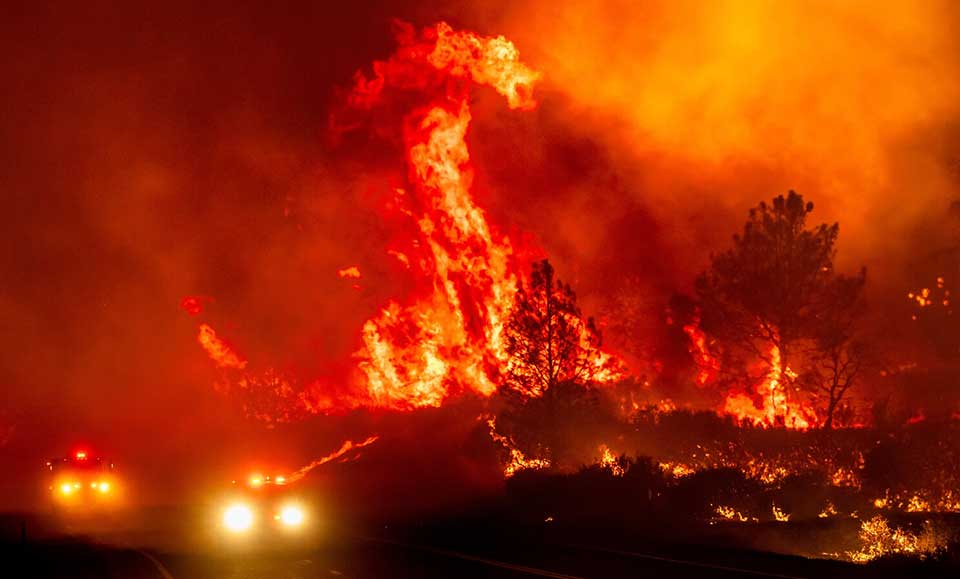
LOS ANGELES-So far in 2024, wildfires have burned over 800,000 acres throughout the state of California and destroyed thousands of structures and properties. Climate change is making wildfires worse and the trend is expected to continue without serious intervention.
Data shows that low-income people, marginalized communities, and farm workers face greater risks from wildfires and wildfire-associated air pollution.
This summer’s largest fire, the Park Fire, blazed through nearly 430,000 acres of Northern California in late July and early August, becoming the fourth-largest wildfire in California history. In Southern California, the Borel fire destroyed almost 60,000 acres in Kern County, largely in the Sequoia National Forest.
Scientists agree that the summer wildfire season in California is becoming more intense over time, a direct result of human-driven climate change. Climate change creates hotter, dryer summers, and combined with poor forest management, the result is the perfect set of conditions for wildfires to start and spread widely and rapidly. 2023 was the hottest year on record, and 2024 is predicted to set a new record.
Working-class people and the elderly are the groups most impacted by wildfires in California. A 2021 study published in the International Journal of Environmental and Public Health found that California communities in areas beset by frequent wildfires are more likely to be low-income and have greater proportions of elderly and Native American residents.
These communities, which already tend to have limited access to healthcare and other social services are at a higher risk for displacement and adverse health effects related to smoke and extreme heat.
In July, researchers at the University of California Irvine published an article in Environmental Research Health that further highlights the burdens of wildfires on low-income and minority communities in California. The study documents that communities in Southern California face smoke and wildfires more often and more intensely than in the past and that poor and exploited populations struggle the most to respond and protect themselves from these challenges.
In the last two decades, exposure to wildfires has more than doubled for U.S. populations. In California alone, the scale of summer burned areas has increased by five times from 1996-2021 compared to the period from 1971-1995. Additionally, the California fire season is starting earlier and ending later than in previous years as conditions become increasingly hot and dry.
Wildfire smoke is a mixture of toxic gases and fine particles that can profoundly impact people’s physical health. It can cause difficulty breathing, irritated eyes, skin rashes, headaches, throat swelling, and more. Those with underlying conditions like asthma or heart problems are especially affected, as wildfire smoke can cause flare-ups and increase the risk of heart attack and stroke.
In the short term, exposure to wildfire smoke drives up emergency room visits for respiratory issues. Inhaling wildfire smoke also leads to devastating long-term health effects.
A recent UCLA study shows that chronic wildfire smoke exposure leads to the development of long-term diseases and links over 50,000 deaths between 2008-2018 to wildfire inhalation. A study from researchers at Stanford and Komodo Health found an enormous increase in childhood asthma related to wildfire smoke, particularly among Latino children.
In addition to cardiovascular diseases, new studies also show that wildfire smoke exposes people to cancer-causing chemicals and leads to increased rates of lung cancer and brain tumors.
People’s mental health is also at risk from wildfires. Wildfires, even the threat of wildfires, cause enormous fear, stress, and anxiety. The threat that one’s home, livelihood, family, and community may be destroyed or harmed causes feelings of fear and hopelessness. Evacuations cause extra pain and stress when people have to leave behind pets and cherished property.
The UCI study also identified a number of ways that communities and local governments could be better prepared for wildfires. Residents interviewed in the study expressed a need for more resources to help mitigate fire risk and help residents forced to evacuate, for example stocking community centers with emergency kits.
Similarly, the study noted a lack of adequate postfire assistance offered to disadvantaged communities. Some of the residents interviewed by the researchers mentioned receiving no information about evacuation centers or appropriate steps to take or people to contact for aid.
Another problem the study highlighted was a lack of effective communication of official warnings for fires and evacuation zones. In some cases, warnings did not reach all residents in affected areas or reached people through word of mouth only, and in other cases populations of monolingual Spanish speakers received warnings and evacuation instructions in English.
Face special risks
Farmworkers in California experience heightened levels of risk and impact from the wildfires affecting the state, largely as a result of policy. A recent study from researchers at UC Irvine and the NSF National Center for Atmospheric Research documents that a combination of increasing wildfires and anti-worker policy expose California farmworkers to dangerous conditions for their health and safety. Using data from the 2020 wildfire season in Sonoma County, California, the researchers showed that farmworkers are exposed to excessive levels of toxic air pollution from wildfire smoke.
A driving cause of this dangerous exposure comes from the Agricultural Pass Program. Adopted by Sonoma County in 2017, the program allows farm workers to continue working in mandatory evacuation zones, areas where the conditions are deemed hazardous to the general population.
The study examined the application of the program, finding that the pass-granting process was haphazard, lacking clear guidelines on what conditions were acceptably safe for farmworkers to labor in. Part of the problem the researchers uncovered was a lack of adequate air quality monitoring, little oversight of the Pass Program and its application, and low safety standards required of employers.
The purpose of the Agricultural Pass Program, which local governments throughout the state may voluntarily adopt, is to prevent losses from natural disasters in commercial agriculture by allowing workers to enter restricted areas, such as wildfire evacuation zones.
Designed to safeguard employers’ profits at the expense of worker safety, the program relies on employers to monitor safety conditions and contains no clear guidelines for the approval process. Farm and agricultural workers themselves, who largely hail from socially disadvantaged groups including undocumented immigrants, have been left out of the decision making process regarding their own safety at all levels.
Moreover, investigative reporting from the Los Angeles Times and Capital & Main shows steep reductions in California’s enforcement of heat-protection laws for outdoor laborers, notably farmworkers. Extreme heat conditions often accompany wildfire risks, leading in some cases to double impacts on workers.
Their reporting highlights drops in workplace inspection frequency over the last few years from the California Division of Occupational Safety and Health (Cal/OSHA), likely caused by staffing issues.
Taking advantage of the reduced oversight, employers violate workers rights by denying legally mandated shade and water breaks and failing to provide heat-illness prevention plans and respirators. To combat these worrying trends, California Senator Dave Cortese and Assembly Member Robert Rivas authored Senate Bill 1299, which would establish workers’ compensation in cases of heat illness.
The bill makes it so that if a worker suffers a heat-related injury while working outdoors, it is presumed to be a workplace injury and the burden to prove otherwise lies with the employer. Currently, the bill has passed both houses of the California legislature and awaits Governor Gavin Newsom to sign it into law.
Wildfire prevention on the ballot
California Ballot Proposition 4, known officially as the Safe Drinking Water, Wildfire Prevention, Drought Preparedness, and Clean Air Bond Act of 2024, would allow the state to sell a $10 billion bond to fund projects and programs that address the impacts of climate change. $1.5 billion of these funds would be slated toward managing forest health and preventing wildfires. If passed, the measure would make huge funds available for state and local agencies to finance projects that reduce wildfire risk, increase community responses and resilience, and restore forests and landscapes. The text of the proposition cites the frightening increase in wildfire frequency and intensity as well as other effects of climate change, such as extreme heat and drought.
A broad coalition of groups and associations support the bill including Clean Water Action, the National Wildlife Federation, the Nature Conservancy, the California Labor Federation, California firefighters, and the Environmental Defense Fund. Supporters cite the urgency of addressing the impacts of climate change and the necessity to allocate state resources to fight these challenges head-on.










